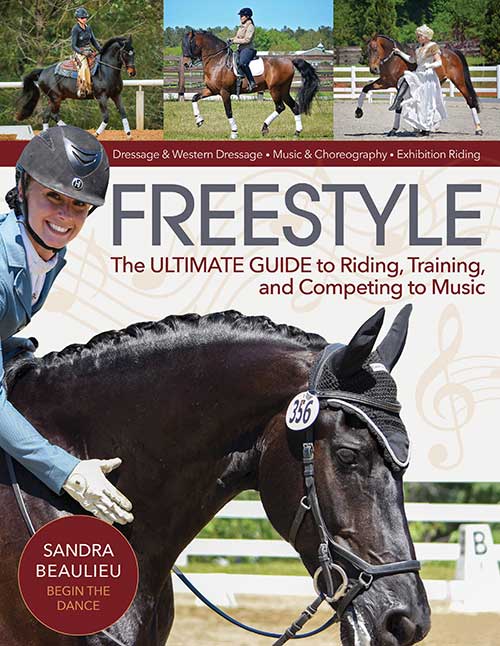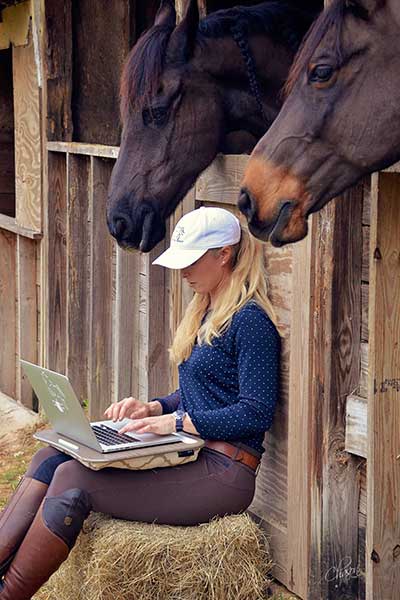
by Sandra Beaulieu
I believe that riding horses is similar to playing golf. It requires patience, body control, and the ability to focus. However, there is one big difference ... the golf club isn’t alive! There really isn’t much else that compares to riding a horse. Ballroom dancing is similar, perhaps more so if you imagine a partner who speaks a different language. Riding horses requires us to learn their language, adjust our natural reactions, and develop feel and timing.
When training a horse, you are dealing with an emotional animal that is so aware of body language it is as if he can read your mind. Music connects with humans on an emotional level and can affect us strongly. If we are affected in a positive way—our mood brightens or our energy is balanced—then the horse will feel the benefits of that as well.
Music can also improve the way we progress through the Training Scale—the six classical building blocks of horse training: rhythm, suppleness, contact, impulsion, straightness, and collection. Rhythm and tempo are at the “base” of the Training Scale, with the other building blocks progressively “stacked” upon them. Perhaps you have a young horse that is learning how to maintain a steady trot, or you are a beginner rider that is learning how to post. In these cases, music can regulate your body, helping you focus on a metronome-like beat in a fun way.
With modern technology, there are many ways to find and save music you like. First, you need to learn how to determine what music works with your horse’s stride. This will give you a starting point, and from there, you can find music with the same rhythm as your horse. When you ride to a song with the same walk, trot, and canter beat as your horse, wonderful things will happen. The music will help you and your horse become “in sync,” and it will help develop a steadier connection, as well as better engagement of the horse’s hind end and lift of the horse’s back. The reason for the latter is that your seat is the most important tool you have to balance your horse. If your seat is moving in a steady beat, it will encourage the horse to lift up underneath you.
Here are just some of the many benefits of riding to music:
- Improving mood and cooperation.
- Increasing forward energy.
- Slowing a rushing horse.
- Developing a more effective seat.

Here are three exercises using music to develop a more effective seat:
Exercise 1: Match Your Seat Bones
As you walk, trot, or canter, play a song that has a strong beat that matches your horse’s stride at that gait. Focus intently on the beat and imagine your seat bones are communicating that beat to your horse. You can close your eyes to focus more intently on the connection between the music and your seat bones.
Exercise 2: Make a Sound
Sometimes it helps to make a sound out loud to help emphasize the tempo of the music in your body, such as, “now, now, now” or “down, down, down” to help you accentuate the beat. This also helps you breathe more freely, and the horse will listen to your voice and tune into the sound. As an alternative to repeating a sound, you can sing a song. When I was really young, my riding instructor had me sing, “Mary Had a Little Lamb” over cross-rails to help me remember to breathe and to set a tempo for my horse.
Exercise 3: Train Your Body
You can use the beat of the music to help improve your sitting trot. Focus on the “up” or “down” beat of the trot, depending on which gives you trouble. Improve your posture by lifting your chest/sternum on the “up” beat of the music. Sit more deeply in the saddle by emphasizing a drop of your weight and energy on the “down” beat. As a rider, you will develop a better feel for your horse’s stride by focusing on the stride at every moment.

This excerpt from Freestyle: The Ultimate Guide to Riding, Training, and Competing to Music by Sandra Beaulieu is reprinted with permission from Trafalgar Square Books (www.horseandriderbooks.com).
Find other interesting stories and informative articles in our section on Health & Education and Dressage.

































